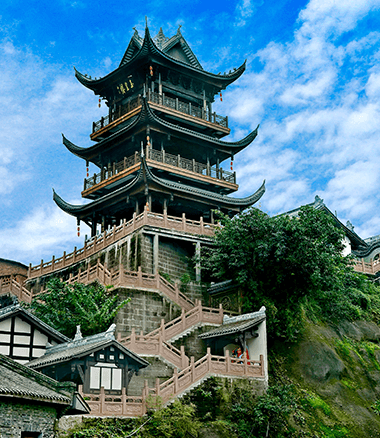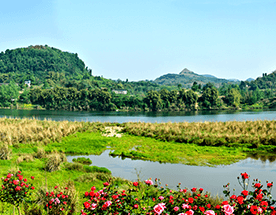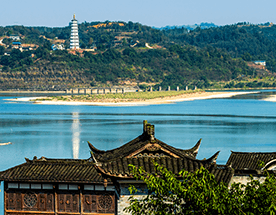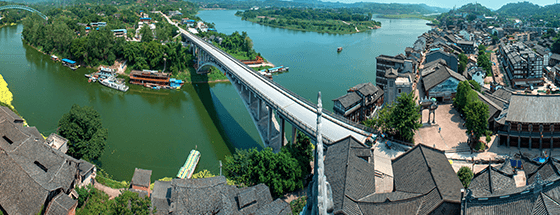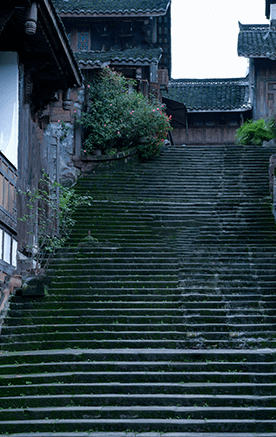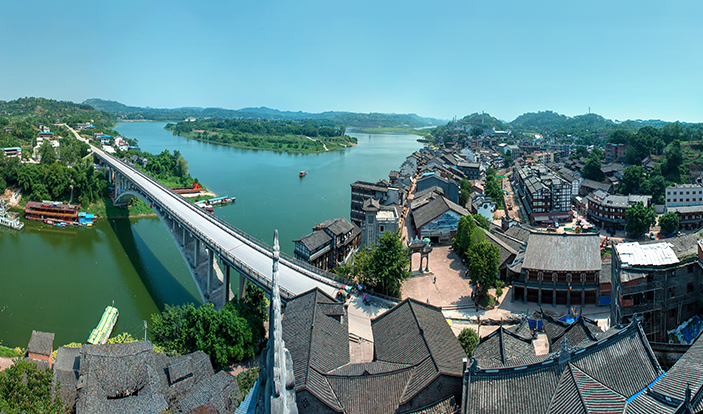
Anju Ancient City (a national AAAA-level tourist site in China) is renown for Da'an Brook (Qiong River), and its name has a beautiful meaning of living and working in peace. Located in Anju Town, Tongliang District, Chongqing, the whole tourist site covers an area of 14.16 square kilometers, including 3 square kilometers of the core area of Anju Ancient City, as well as cultural tourism functional regions such as Heilongzui, Pipa Island, Huangjiaba, Scenic Temple, and more.
Since ancient times, Anju Ancient City has been enjoying developed waterways which go up west Sichuan, and go down Chongqing, Wuhan and Shanghai, and bustled with Sampans, Hanyang ferries, and Anyue boats. Boasting Liquor Gang, Salt Gang, Dragon-plaiting Gang, Slaughter Gang, Weaving Gang, Dyeing Gang, and other guilds, Anju Ancient City was once a vital entrepot in the upper reaches of the Yangtze River. Located 17 km from urban Tongliang, 23 km from urban Hechuan, and 66 km from urban Chongqing, Anju Ancient City has a prominent regional advantage as a central node of western Chongqing tourism circuit involving Dazu Rock Carvings, Hechuan Diaoyu Fortress, Tongnan Yang's Former Residence, etc. Visitors can get here by driving along Chongqing-Suining Expressway, and then exiting from Shaoyun Interchange and driving for 3.5 km. At 30°N, Anju Ancient City has been endowed with timeless mystique since ancient times.
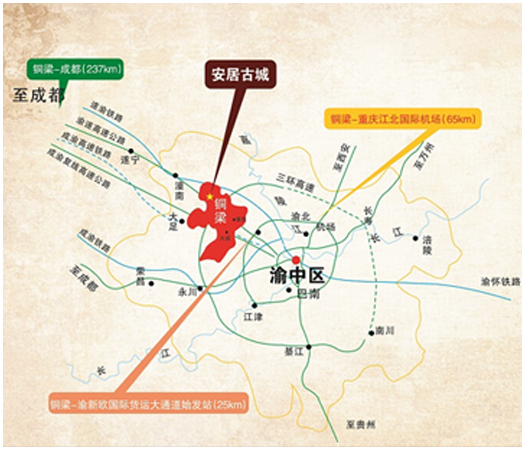
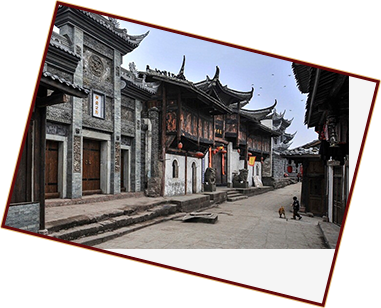
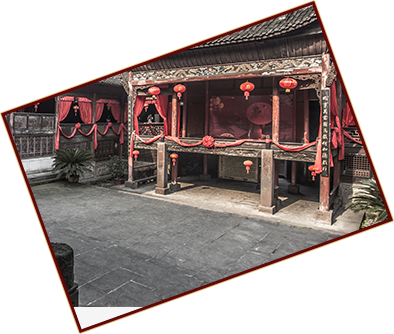
As early as more than 20,000 years ago, there were already human settlements in Anju Ancient City. Villages were formed there in Han Dynasty, and it became a waterway hub in the lower reaches of the Fu River in Sui and Tang Dynasty. Anju was established as a county in the 8th year of Kaihuang's reign in the Sui Dynasty (588 AD), 7th year of Xining's reign in Northern Song Dynasty (1074 AD), and 17th year of Chenghua's reign in Ming Dynasty (1481 AD), and merged into Tongliang County in the 6th year of Yongzheng's reign in Qing Dynasty (1728 AD). Anju Ancient City is an exceptionally well-preserved, large-scale, and three-dimensional and layered example of geomantic treasure land. It starts from the Feifeng Mountain in the east, surrounds the Hualong Mountain in the south, spans the Wumu Brook in the west and borders on Guanzi Mountain, and faces the Fu River in the north, stretches itself, steep and high, and rises steeply along the riverbank. There are 197 municipal- and district-level heritage sites as well as 1 national intangible cultural heritage. The city boasts many ancestral shrines, guilds, chambers of commerce, and the Society of Brothers. The “9 palaces and 18 temples” shine for their historical content, and Anju Nine Scenes are marvelous.
Besides, it is an over 1,000-year-old town inclusive of ancient county culture, Bayu culture, religious culture, literary culture, immigrant culture, Anti-Japanese War culture and dragon culture. The County Government Office, Confucius Temple, Academy and Town God Temple jointly play stories of the county. Bayu landscapes are depicted in Traditional residences built leaning the mountains, sinuous ancient streets and narrow lanes in addition to unique suspended houses, work songs of boat trackers in Sichuan Province and Anju land boating. Religious charm is conveyed by the millennium ancient Scenic Temple, Heavenly Palace, inscriptions by Han Yu and Mi Fu, and the inland Temple of Queen of Heaven. The millennium academy has cultivated 200 Ju Ren (successful candidates in the imperial examinations at the provincial level), 23 Jinshies (successful candidates in the highest imperial civil service examination), and 4 Han Lin (members of the Imperial Academy). Han Lin Wang and Wu have been families of scholars for generations, which has become a favorite tale. The poignant story of “Emerald Hairpin” is a reflection of true love in the world. Immigrants from Hubei and Hunan Provinces as well as traveling merchants from north to south gathered in Anju Dock. Diversified culture is embodied in the Jiangxi style Wanshou Palace, Hui-style Mazu Temple, and Hunan-style Lianxi Temple. The 13th to 17th session of Whampoa Military Academy have settled in Anju for 5 years, cultivating 8,425 Anti-Japanese War talents. Tracks have been made here by Jiang Jieshi, Feng Yuxiang, Liu Bocheng, etc.In addition, Anju is well known for its various dragons including Giant Wiggling Dragon, Straw Dragon, Vitex Dragon, Vegetable Dragon, Shoulder Pole Dragon, and sparkling Fire Dragon. Moreover, Anju has longlasting cultural activities including playing dragon lanterns, grabbing burning dragons, and pulling dragon horns, which convey its diversified dragon culture.
Anju Ancient City is located at the intersection of the Qiong River and Fu River. The Fu River originates from Songpan in Sichuan Province, and merges with the Qiong River and Wumu Brook in the town after running thousand miles. As a Tang poem goes, “The towering town is surrounded by water on three sides”. As soon as Anju Power Plant was built in early 1990s, Anju Ancient City has been enjoying unique natural landscape of “2 rivers and 6 banks”. Riverbank “Anju Eight Scenes”—Winding Hualong Mountain, Feifeng Mountain of Spirit, Bolun Holding the Moon, Stone Horse Bringing Prosperity, Auspicious Spray of Qiong River, Purple Haze, Guanjian Splash Cup, and Night View of Holy Water, which are all breathtaking. The Nine Dragons Stone with a tragic legend, the Crocodile Stone, Frog Stone, and Camel Stone stand still and bless the town. In Anju National Wetland Park, there are immense pieces of reeds and meadows, wild ducks are tumbling merrily about in the water, white egrets are flying in a row into the blue sky. The Pipa Island is surrounded by water on all four sides and encircled by two rivers, like two dragons playing with a pearl, making it an ideal place in geomantic theory. Heilongzui leans on mountains and is bordered by the rivers, facing the ancient town across the rivers and enjoying beautiful scenery. An ancient poem versed that, “Anju is a nice place to reside, cool as rivers pass by; Wild bamboo adding viridity to the town, flowers leading to lovely house; Flying smoke casting three miles, torches of fishermen spilling out over the river; Being worried I drink the mash, too often I pour to be sober.”
So far Anju Ancient City has been successfully established as a national AAAA tourist site.
Now we are sparing no effort to establish a national AAAAA tourist site, Anju National Wetland Park, and National Tourism Resort. You will be overwhelmed by thorough connotations and quality services when you come!
